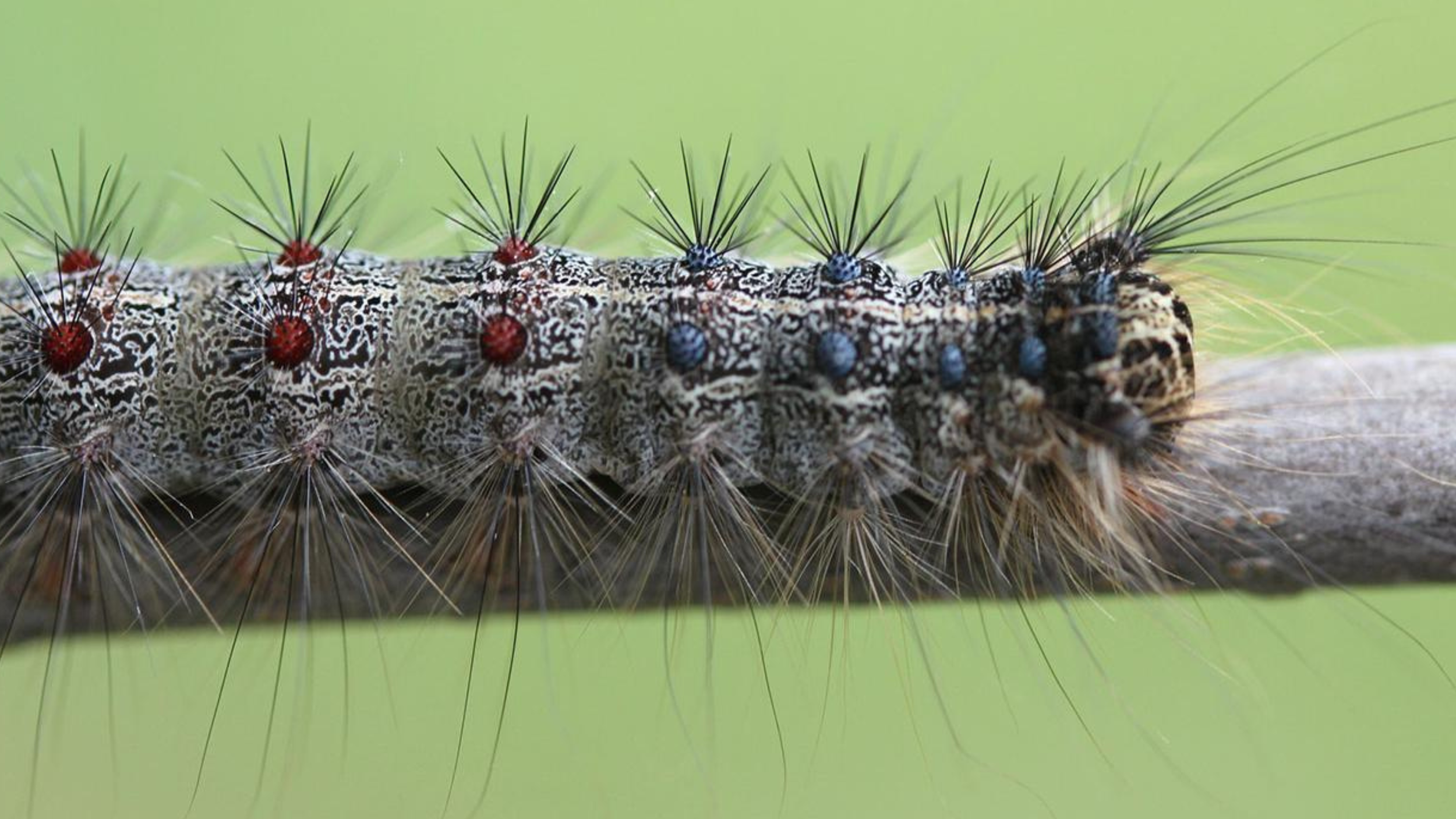
Spongy Moth
What is a spongy moth?
Formerly known as “Gypsy Moth,” Lymantria dispar is most often noticed in its caterpillar stage as it eats the leaves off our trees, leaving slimy frass (insect poop!) on our decks and vehicles.
Its preferred host tree is oaks, which are a large component of many forests in Barry County, but it will also use black cherry, Colorado blue spruce, basswood, and apple trees, among many others. The caterpillars are most active during dawn and dusk but will feed continuously until they pupate (or make their cocoon).
How did spongy moth get to North America?
Spongy moth is not native to Michigan. Originally from Eurasia, it was introduced to North America in the 1860s. Etienne L. Trouvelot, a French entomologist in Medford, MA, accidentally released spongy moths while experimenting with various species for silk production.
Since then, the moth has become a significant pest across the northeastern United States, causing damage to various tree species. Early control efforts, including widespread pesticide use, were largely ineffective.
Life Cycle
The spongy moth has a defined life cycle consisting of 4-stages. It begins with the egg stage, where each fuzzy, rust-colored egg mass contains 600-1000 eggs deposited by female moths on the underside of branches and decking, crooks of trees, awnings, and gutters.
These eggs will remain viable through the winter and (depending on the weather) hatch from late April to early May into larvae (aka caterpillars) that feed continuously and may cause severe to complete tree defoliation.
While it may seem like an eternity while they are feeding, thankfully, caterpillars are a short-lived portion of the moth’s life cycle, lasting about 7 to 8 weeks. The weather dramatically impacts the timing of these stages, but caterpillars are typically feeding from late April/May through late June/July each year.
Once caterpillars are ready to become moths, they enter the pupa stage (cocoon) for 1 to 2 weeks in June/July and finally emerge as moths. Adult moths do not feed and only exist to reproduce, starting the annual cycle all over again. One female will produce only one egg mass in her lifetime.
Image of NPV infected spongy moth, courtesy of Dr. Alison Hunter, University of Chicago
More resources!
MSU Extension Integrated Pest Management - Spongy Moth
Dealing with Spongy Moth Around Your Home or Property (MSU Extension)
Spongy Moth Basics (MSU Extension)
Spongy Moth Facts & Info (State of Michigan - Invasive Species)
***For more information on how predators and pathogens interact to impact cyclical pest outbreaks, research from Dr. Dywer and colleagues is available to read in Nature, a scientific journal HERE.
Virus + Fungus = Declining Spongy Moth
Several native birds and some rodents feed on spongy moth caterpillars and pupae. However, they are not a preferred food for any Michigan wildlife and predation is insufficient to control outbreaks during large infestations.
When caterpillar densities are high, it is the perfect environment for the nucleopolyhedrovirus (NPV) to spread rapidly and wreak havoc on the population, usually leading to a noticeable decline. This virus, often combined with a fungal infection, typically ends the 5 to 7-year outbreak cycle of these troublesome pests.
Lucky for us, Dr. Greg Dwyer, from the University of Chicago, owns a cabin in Barry County and noticed this pest eating his trees! Dr. Dwyer has found that nearly 99% of caterpillars his team sampled in Barry County during Summer 2024 are indeed infected with this virus, which is a hopeful sign that we will see a dramatic reduction of this pest across the county this season.
The fungal pathogen Entomophaga maimaima is native to Japan but has been found in the U.S. for nearly 30 years, keeping populations of spongy moths in check across its introduced range. This fungus is a highly effective “natural enemy” of the spongy moth when environmental conditions are right. Like all fungi, this species relies on cool, moist conditions to spread.
Warmer and drier Spring weather may lead to increased problems from spongy moths due to a decline in the lethal combination of fungus and virus needed to keep this pest in check.
What is going on in Barry County?
With funding from Barry County, Barry Conservation District conducted egg mass surveys on 31 sites across the most forested areas of Barry County during Fall 2024.
The map illustrates in red areas where the number of viable egg masses detected indicated potential for defoliation during the next growing season (2025).
The graph below also illustrates the distribution of egg masses across our sample sites, with the black line indicating the threshold (>1000/egg masses per acre) where we may expect to see severe defoliation and potential for tree decline/death.
While we found that 7 of 31 sites had viable egg masses that may lead to notable defoliation in 2025, our data largely agree with Michigan DNR’s assessment that populations in SW Michigan are in decline.
Additional follow-up in high-density sites during Winter 2024/2025 further indicates reduced viable egg masses compared to our surveys in the Fall. We will continue to refine our methods and partnership with the Dwyer Lab to bring residents up-to-date information on this pest!
***Note in the map above we have used polygons to indicate the sampling area so landowner privacy is protected.
Want to survey for spongy moth on your own property?
Learn how using this free and easy to understand protocol from Penn State Extension!
How to get rid of spongy moth caterpillars..
-

Spring & Summer
Capturing feeding caterpillars by wrapping folded burlap cloth around the tree trunks of areas near buildings or select oaks trees to protect those trees and reduce frass. This will trick them into hiding in the fold.
Scrape the caterpillars into soapy water, burn, and/or crush and dispose of them in your garbage.
Duck tape is no longer recommended due to incidents of small animals getting stuck.
-

Fall & Winter
Scrape egg masses into soapy water. Be sure not to crush egg masses and leave them on the ground, as some eggs could still survive and hatch. Keep egg masses in soapy water for at least 24 hours will kill all the eggs in a mass.
Burning them off can work, but operate at your own risk.
-

What about spraying?
Typically done by professionals, the cost can be high.
This must be done in early spring (late April/early May) and should be arranged in advance of anticipated defoliation.
The insecticide used is a Bacillus thuringiensis var. Kurstaki (BtK), a naturally occurring soil bacteria, is sprayed directly on leaves and ingested by feeding caterpillars.
Who can spray for me?
Smaller Property Treatments (Less than 10 acres)
Bartlett Tree Experts: 616-399-9446, www.bartlett.com
Honeytree Arborist Service: 616-293-5318, honeytreenursery@yahoo.com
Monarch Tree Services: 616-551-7032, patmorren@monarchtreeservices.com
Parshall Tree Care Experts: 616-260-1031, james.retzlaff@parshalltreecare.com
Wise Owl Tree Company: 616-840-2947, info@summitlandscapeinc.com
Aerial Treatment for Large Properties
Al Schiffer, Al's Aerial Spraying: 989-834-5067, Al400@aol.com
Hamilton Helicopters: 616-291-5808, Info@HamiltonHelicopters.com
Lakeshore Ag & Aerial: 616-848-6509, Dirk@lakeshoreagtech.com
Zahm’s Aerial Enterprises LLC: 616-498-9813, zahmsaerial.com
What have other communities done?
The State of Michigan considers spongy moth to be naturalized and not a priority species to combat using public resources. Treatment for this pest is considered the responsibility of the landowner.
If there is support in your community for spending funds on controlling spongy moth, any county, township, municipality, homeowners’ association, or individual may coordinate aerial spraying of Bacillus thuringiensis var. Kurstaki (BtK) through a private company if desired.
Examples:
In 2022, Ada Township (Kent County) treated 3000 acres for $200,000 ($67 per acre). Click HERE for more information on Ada Township’s project.
Cascade Township (Kent County) also used aerial spraying for a similar project cost. Click HERE for more information on Cascade Township’s project.







